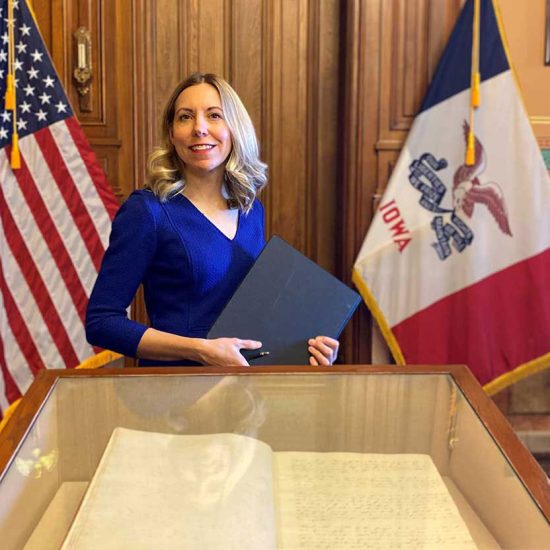

BECOMING THE PASTOR’S WIFE: How Marriage Replaced Ordination as a Woman’s Path to Ministry. By Beth Allison Barr. Grand Rapids, MI: Brazos Press, 2025. Xxi + 232 pages.
After Cheryl and I were engaged, I decided to change my degree program from an M.A. to an M.Div. so I could pursue ordination. I told her that while this move might help my academic career, she didn’t need to worry about becoming a pastor’s wife, as I didn’t intend to be a pastor. It didn’t work out the way I envisioned since I spent a quarter century in pastoral ministry, which meant that she spent a lot of years as a pastor’s wife. Even though my ministries have been in a mainline denomination that ordains women (women are serving or have served as General Minister and President), that doesn’t mean that she and other mainline “pastor’s wives” haven’t had to deal with certain expectations, including the possibility that in hiring a male pastor the congregation gets two for the price of one. This happens even when the church insists that they don’t have any expectations of the pastor’s wife. Nevertheless, while certain expectations cross boundaries, in the evangelical world where patriarchalism is more present, things can be significantly different.

Robert D. Cornwall
In Becoming the Pastor’s Wife: How Marriage Replaced Ordination as a Woman’s Path to Ministry, Beth Allison Barr builds on her earlier study of evangelical patriarchalism in The Making of Biblical Womanhood: How the Subjugation of Women Became Gospel Truth, to address an evangelical world where a woman’s path to ministry requires marriage to a male pastor rather than ordination. Thus, she writes here about the emergence of the idea of a pastor’s wife serving as a ministry adjunct to the pastor. In other words, she writes about the kinds of expectations placed on the pastor’s wife, such that she is expected to be a pillar of his ministry. Barr brings to this conversation her vocation as a medieval church historian (she is the James Vardaman Endowed Professor of History at Baylor University) together with her personal experience of being the wife of a Baptist pastor. Therefore, she has experienced being a pastor’s wife, primarily in the context of Southern Baptist churches, such that this book draws on her personal experience as well as her expertise as a historian.
The book’s subtitle speaks to a particular dynamic at work in many evangelical churches, especially Southern Baptist Churches, which do not allow women to be ordained as pastors. Thus, women who feel a call to ministry are often directed toward becoming pastor’s wives. A woman’s commitment to this calling may have implications for her husband’s success. As Barr notes in her introduction, “Becoming a pastor’s wife is becoming a ‘total partner’ with your husband in his job” (p. xiii). This reality is unlike any other vocation! As a result, numerous books and manuals have been written for pastor’s wives that cover everything from raising children to how to dress. She offers an appendix that lists in chronological order the books and manuals that have appeared since 1923 (it takes up nearly five pages, double column, relatively small print).
Of course, the idea that a woman’s path to ministry would involve becoming a pastor’s wife is a rather recent novelty. It wasn’t a possibility, at least in the Christian West, before the time of the Reformation. For centuries prior to the Reformation, clergy were expected to be celibate (though many had concubines), so if a woman had a ministry calling, she would have pursued it in other ways. Some women, including Hildegard of Bingen, were rather powerful in their work. However, they did have to deal with patriarchal attitudes that sought to limit their influence. While the role of the pastor’s wife may have been born at the time of the Reformation, Barr writes that “it wasn’t until the second half of the twentieth century that it was elevated as the highest calling for many Protestant women, waxing in importance as more independently authoritative roles for women waned” (p. xix).
Barr begins this intriguing look at the emergence of the role of the pastor’s wife as a path to ministry in contexts that limit women’s opportunities to seek ordination and pastoral leadership, with a chapter titled “Where Is Peter’s Wife?” In this chapter, Barr introduces us to contemporary experiences of women seeking ordination, together with biblical and historical examples of women in ministry (such as the example of Prisca and Junia, two women connected with Paul’s ministries. She asks the question of the location of Peter’s wife since Paul mentions her in 1 Corinthians 9 because, in Barr’s context, the expectation was that clergy would be male and married. So, where was his wife?
Having laid out a context for her exploration of contemporary stories of women seeking ordination and the resistance to that, she speaks of biblical examples of women in ministry. From there, Barr the medieval historian introduces us to “When Women Were Priests” (chapter 2). She offers this important chapter as a response to the claims made by complementarian opponents of women’s ordination that historic Christianity has always been a male-only ministry. History, as she demonstrates, does not support that claim. We are pointed to the Priscilla Catacombs in Rome, which is one of the largest ancient burial spaces in that city. In these catacombs, one will find evidence that the churches in Rome had female leaders. The catacombs that belonged to a female patron provide numerous images of women performing sacred rites. In this chapter, Barr weaves contemporary stories of resistance with historical stories of women who held important roles in the church.
Chapter 3 continues the historical conversation with a chapter titled “The Not-So-Hidden History of Medieval Women’s Ordination.” She introduces the chapter with her own story of having to deal with questions about her vocational path that involved a PhD in history. Then she turns to a woman named Milburga, the descendant of the most important royal families in early medieval Britain. This woman born in the seventh century would become a Benedictine nun and abbess of one of the most important monasteries in eighth-century England. While much of her story comes from an eleventh-century hagiography, it is clear that she provided pastoral leadership not only over women but men as well. It should be known that an abbess was equivalent to a bishop. Barr uses Milburga’s story to explore the idea of ordination, which didn’t develop in its more modern form until much later. But, in terms of ministry, she was recognized as a leader of the church. Again, history offers points of resistance to claims that ministry has been an all-male affair.
Chapter 4, titled “The Rise of the Pastor’s Wife,” begins with Barr noting the power that medieval nuns had since not all of them were cloistered. Hildegard is an important example of a nun and abbess who had a public ministry (with papal approval). At the same time, there were patriarchal beliefs that centered on the problem of female bodies, that focused on sexual purity. This led to the concept of pastoral celibacy since ministry and sex were deemed problematic. The Reformation changed things, such that with the abandonment of celibacy and married clergy, the age of the pastor’s wife was born. Barr writes that while the role of the pastor’s wife became “a respectable position for women in the church,” it “could never be more than a mediated role.” For their role in the church was dependent on a man (p. 85).
Having moved through history in these first four chapters, Chapter 5 transitions from history to more contemporary issues. The title of the chapter is suggestive of what many churches expect to get when hiring a married male pastor: “Two for the Price of One.” Barr shares stories of women who tried to live up to expectations, including expectations that were taught in classes at SBC seminaries, such that we learn how an entire class was dedicated to learning how to pack the husband’s suitcase. What we learn here is that the pastor’s wife, at least in the context of the SBC as it rolled back women’s access to ordination, is that they essentially served as universal spare parts. Again, we get a bit of history, especially regarding wives at the time of the Reformation. While the idea of the pastor’s wife is lifted up in these churches, the concept of the pastor’s wife is not biblical. It is a role that emerged over time after the Reformation. It also reflects the idea that women should be subordinate to men. Chapter 6 follows the previous chapter, exploring the need to be “The Best Pastor’s Wife.” We even learn about an SBC award for the Pastor Wife of the Year. So, who is the best pastor’s wife? While initially it was designed to honor women engaged in the life of the broader church, eventually it was defined in terms of being a companion to her husband to whom she joyfully submits. Most recipients are the wives of mega-church pastors.
Chapter 7 is titled “The (SBC) Road Less Traveled.” Here we learn how the SBC approach to women in ministry changed over time. Whereas the SBC had been to some degree open to women pursuing ordination and serving as pastors, things began to change in the 1980s. With the changes to opportunities taking hold, the safest path to ministry was being a pastor’s wife. In Chapter 8, titled “The Cost of Dorothy’s Hats” (a reference to Dorothy Patterson’s penchant for hats — Patterson, the wife of SBC conservative leader Paige Patterson, was a leading figure in the domestication of women in the SBC) — we learn more about the efforts to undermine women in ministry and some of the consequences, including serving as a contributing factor in the clergy sexual abuse scandal in the SBC (and the cover-up).
Barr contrasts two stories, that of Joyce Rogers, wife of Adrian Rogers, one of the leaders of the conservative takeover of the SBC, with another woman, Maria Acacia. It is the latter woman who is the focus as her husband not only engaged in a long-term relationship with a woman who came to him for counseling, which is an example of sexual abuse, by physically abusing his wife. Despite attempts to bring this to the attention of church leaders this was all ignored, up to the highest levels of the church. Barr does great work here excavating this story, revealing it to her readers so we see the consequences of patriarchy and toxic masculinity. The SBC attitude was to forgive and forget, which is a problem and likely will continue to be a problem as they dig deeper into patriarchy.
The final chapter is titled “Together for the Gospel.” Having laid out the consequences of patriarchal forms of religious life that made the role of the pastor’s wife consequential and yet subordinate to male leaders, she ends with a word of hope. While recognizing the realities of the moment, she does believe the SBC can be different. That is because there are examples from the past of women who held positions of leadership in the church. By lifting them up she hopes to offer another path for women to take going forward. The issue here is not that some women will be married to pastors and play significant roles in the churches their husbands serve. The issue is that in many cases that is the only pathway for women to serve, and that leads to exploitation.
While the focus is on predominantly white churches, pastor’s wives (First Ladies) often function very differently in many Black Churches. Pastor’s wives in that context often have important leadership roles in the life of the church that often include preaching. As for Barr, she acknowledges that after being a pastor’s wife for twenty-five years, she no longer worries about the expectations. She does what she can, doing what God has called her to do. She does the things she wants to do and does not fulfill the expectations of others. That’s the way it should be! It should probably be noted that in churches that ordain women, the pastor’s husband rarely faces the same expectations. So, while history shows how the role of the pastor’s wife was used to push women out of ministry, it doesn’t have to be that way. Pastor’s wives, she believes, can even help change the church for the better.
While the story Beth Allison Barr tells in Becoming the Pastor’s Wife focuses on evangelical churches that have placed barriers and limits on the roles women can have in the life of the church, even women who are married to male pastors in mainline churches will likely resonate with some of the expectations placed on pastor’s wives. Barr’s own story, along with the stories she tells about others who have been pastor’s wives, including the historical stories, open up important possibilities for conversation about ministry roles in the church, whether ordained or not. As is true of her earlier book, Making of Biblical Womanhood, her Becoming the Pastor’s Wife is a poignant read that reveals important points about gender and the church.
This review originally appeared on BobCornwall.com.
Robert D. Cornwall is an ordained minister in the Christian Church (Disciples of Christ). Now retired from his ministry at Central Woodward Christian Church (Disciples of Christ) of Troy, Michigan, he serves as Minister-at-Large in Troy. He holds a Ph.D. in Historical Theology from Fuller Theological Seminary and is the author of numerous books, including his latest “Second Thoughts about the Second Coming: Understanding the End Times, Our Future, and Christian Hope” coauthored with Ronald J. Allen. His blog Ponderings on a Faith Journey can be found here.






